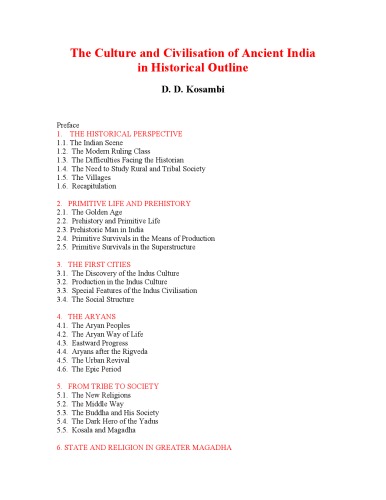

Most ebook files are in PDF format, so you can easily read them using various software such as Foxit Reader or directly on the Google Chrome browser.
Some ebook files are released by publishers in other formats such as .awz, .mobi, .epub, .fb2, etc. You may need to install specific software to read these formats on mobile/PC, such as Calibre.
Please read the tutorial at this link: https://ebookbell.com/faq
We offer FREE conversion to the popular formats you request; however, this may take some time. Therefore, right after payment, please email us, and we will try to provide the service as quickly as possible.
For some exceptional file formats or broken links (if any), please refrain from opening any disputes. Instead, email us first, and we will try to assist within a maximum of 6 hours.
EbookBell Team

4.8
104 reviews
ISBN 13: 9781032342894
Author: D D Kosambi
First published in 1965, The Culture and Civilisation of Ancient India in Historical Outline is a strikingly original work, the first real cultural history of India. The main features of the Indian character are traced back into remote antiquity as the natural outgrowth of historical process. Did the change from food gathering and the pastoral life to agriculture make new religions necessary? Why did the Indian cities vanish with hardly a trace and leave no memory? Who were the Aryans – if any? Why should Buddhism, Jainism, and so many other sects of the same type come into being at one time and in the same region? How could Buddhism spread over so large a part of Asia while dying out completely in the land of its origin? What caused the rise and collapse of the Magadhan empire; was the Gupta empire fundamentally different from its great predecessor, or just one more ‘oriental despotism’? These are some of the many questions handled with great insight, yet in the simplest terms, in this stimulating work. This book will be of interest to students of history, sociology, archaeology, anthropology, cultural studies, South Asian studies and ethnic studies.
1. THE HISTORICAL PERSPECTIVE
1.1. The Indian Scene
1.2. The Modern Ruling Class
1.3. The Difficulties Facing the Historian
1.4. The Need to Study Rural and Tribal Society
1.5. The Villages
1.6. Recapitulation
2. PRIMITIVE LIFE AND PREHISTORY
2.1. The Golden Age
2.2. Prehistory and Primitive Life
2.3. Prehistoric Man in India
2.4. Primitive Survivals in the Means of Production
2.5. Primitive Survivals in the Superstructure
3. THE FIRST CITIES
3.1. The Discovery of the Indus Culture
3.2. Production in the Indus Culture
3.3. Special Features of the Indus Civilisation
3.4. The Social Structure
4. THE ARYANS
4.1. The Aryan Peoples
4.2. The Aryan Way of Life
4.3. Eastward Progress
4.4. Aryans after the Rigveda
4.5. The Urban Revival
4.6. The Epic Period
5. FROM TRIBE TO SOCIETY
5.1. The New Religions
5.2. The Middle Way
5.3. The Buddha and His Society
5.4. The Dark Hero of the Tadus
5.5. Kosala and Magadha
6. STATE AND RELIGION IN GREATER MAGADHA page
6.1. Completion of the Magadhan Conquest
6.2. Magadhan Statecraft
6.3. Administration of the Land
6.4. The State and Commodity Production
6.5. Asoka and the Culmination of the Magadhan Empire
7. TOWARDS FEUDALISM
7.1. The New Priesthood
7.2. The Evolution of Buddhism
7.3. Political and Economic Changes
7.4. Sanskrit Literature and Drama
the culture and civilization
difference between the culture and civilization
how does climate affect the culture and civilization
the law fails to evolve with the culture and civilization
the culture and civilization of ancient india pdf
the culture and civilization tradition
Tags: D D Kosambi, Culture, Civilization